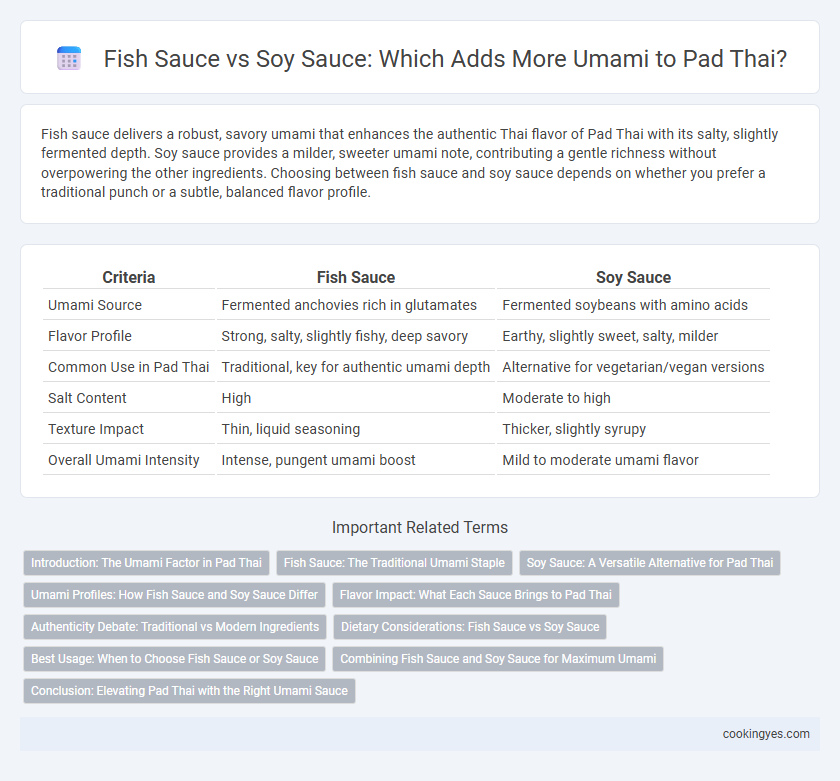Fish sauce delivers a robust, savory umami that enhances the authentic Thai flavor of Pad Thai with its salty, slightly fermented depth. Soy sauce provides a milder, sweeter umami note, contributing a gentle richness without overpowering the other ingredients. Choosing between fish sauce and soy sauce depends on whether you prefer a traditional punch or a subtle, balanced flavor profile.
Table of Comparison
| Criteria | Fish Sauce | Soy Sauce |
|---|---|---|
| Umami Source | Fermented anchovies rich in glutamates | Fermented soybeans with amino acids |
| Flavor Profile | Strong, salty, slightly fishy, deep savory | Earthy, slightly sweet, salty, milder |
| Common Use in Pad Thai | Traditional, key for authentic umami depth | Alternative for vegetarian/vegan versions |
| Salt Content | High | Moderate to high |
| Texture Impact | Thin, liquid seasoning | Thicker, slightly syrupy |
| Overall Umami Intensity | Intense, pungent umami boost | Mild to moderate umami flavor |
Introduction: The Umami Factor in Pad Thai
Fish sauce and soy sauce both contribute distinct umami flavors to Pad Thai, enriching its iconic taste profile. Fish sauce delivers a deep, savory saltiness derived from fermented fish, enhancing the dish's complexity and authenticity. Soy sauce offers a milder, slightly sweet umami that balances the tangy and spicy elements, catering to different taste preferences while maintaining the core flavor harmony.
Fish Sauce: The Traditional Umami Staple
Fish sauce serves as the traditional umami staple in Pad Thai, delivering a deep, savory flavor essential for its authentic taste. Rich in natural glutamates, fish sauce enhances the dish's complexity more effectively than soy sauce, which can introduce a sweeter or saltier profile. Its fermented anchovy base provides the characteristic pungent aroma and nuanced depth that defines genuine Pad Thai.
Soy Sauce: A Versatile Alternative for Pad Thai
Soy sauce offers a versatile alternative to fish sauce in Pad Thai by providing a rich umami flavor with a slightly sweeter and milder profile, making it suitable for vegetarian or vegan diets. Its fermented soybeans deliver essential amino acids that enhance the dish's savory depth without overpowering other ingredients like tamarind and palm sugar. Using soy sauce allows customization of saltiness and complexity, preserving the authentic balance of tangy, sweet, and savory elements crucial for traditional Pad Thai.
Umami Profiles: How Fish Sauce and Soy Sauce Differ
Fish sauce delivers a pronounced umami depth through its rich glutamates derived from fermented fish, imparting a savory, slightly briny complexity essential in authentic Pad Thai. Soy sauce offers a milder umami profile with a balanced blend of sweetness and saltiness, originating from fermented soybeans, which adds a smoother, less pungent flavor. Combining these two sauces can enhance Pad Thai's overall umami balance, blending the intense marine notes of fish sauce with the mellow, earthy tones of soy sauce.
Flavor Impact: What Each Sauce Brings to Pad Thai
Fish sauce delivers a robust umami depth with a salty, slightly sweet, and pungent profile that enhances the authentic Thai flavor of Pad Thai. Soy sauce contributes a milder savory taste with a subtle sweetness and less intense aroma, offering a balanced umami without overpowering other ingredients. Combining both sauces can create a complex flavor harmony, blending the boldness of fish sauce with the smoother notes of soy sauce.
Authenticity Debate: Traditional vs Modern Ingredients
Fish sauce delivers a distinct, savory depth essential for authentic Pad Thai, providing its characteristic umami through fermented anchovies. Soy sauce, often used in modern adaptations, offers a milder, slightly sweeter flavor, appealing to vegetarian or alternative dietary preferences but deviating from traditional taste profiles. The authenticity debate hinges on fish sauce preserving cultural heritage, while soy sauce reflects evolving culinary trends and ingredient accessibility.
Dietary Considerations: Fish Sauce vs Soy Sauce
Fish sauce provides a deeply savory umami flavor in Pad Thai but may contain allergens such as fish proteins, making it unsuitable for vegetarians and those with seafood allergies. Soy sauce offers a plant-based alternative with a rich umami profile, ideal for vegans and individuals avoiding fish products or shellfish allergens. Choosing between fish sauce and soy sauce depends on dietary restrictions and flavor preferences, impacting both nutritional content and allergen considerations in the dish.
Best Usage: When to Choose Fish Sauce or Soy Sauce
Fish sauce delivers a rich, savory umami boost ideal for traditional Pad Thai, enhancing the dish with its deep, salty complexity. Soy sauce provides a milder, slightly sweet flavor, suitable for those seeking a vegetarian alternative or a less intense seasoning. Choose fish sauce for authentic depth and soy sauce for a subtle, plant-based umami profile.
Combining Fish Sauce and Soy Sauce for Maximum Umami
Combining fish sauce and soy sauce in Pad Thai creates a harmonious umami depth by blending salty, savory, and slightly sweet flavors essential to authentic Thai cuisine. Fish sauce contributes a rich, fermented umami profile with hints of oceanic saltiness, while soy sauce adds a smooth, mellow, and slightly sweet soy-derived umami. Balancing these two sauces enhances the overall taste complexity, elevating the characteristic tangy and umami-rich flavor that defines classic Pad Thai.
Conclusion: Elevating Pad Thai with the Right Umami Sauce
Choosing fish sauce over soy sauce enhances Pad Thai's authentic umami depth through its complex, salty, and slightly sweet flavor profile, traditional to Thai cuisine. Fish sauce provides a richer, more distinctive savory umami that perfectly complements the tangy tamarind and crunchy peanuts in Pad Thai. For a genuine, flavorful Pad Thai experience, fish sauce remains the optimal umami enhancer.
Fish sauce vs soy sauce for umami in Pad Thai Infographic

 cookingyes.com
cookingyes.com